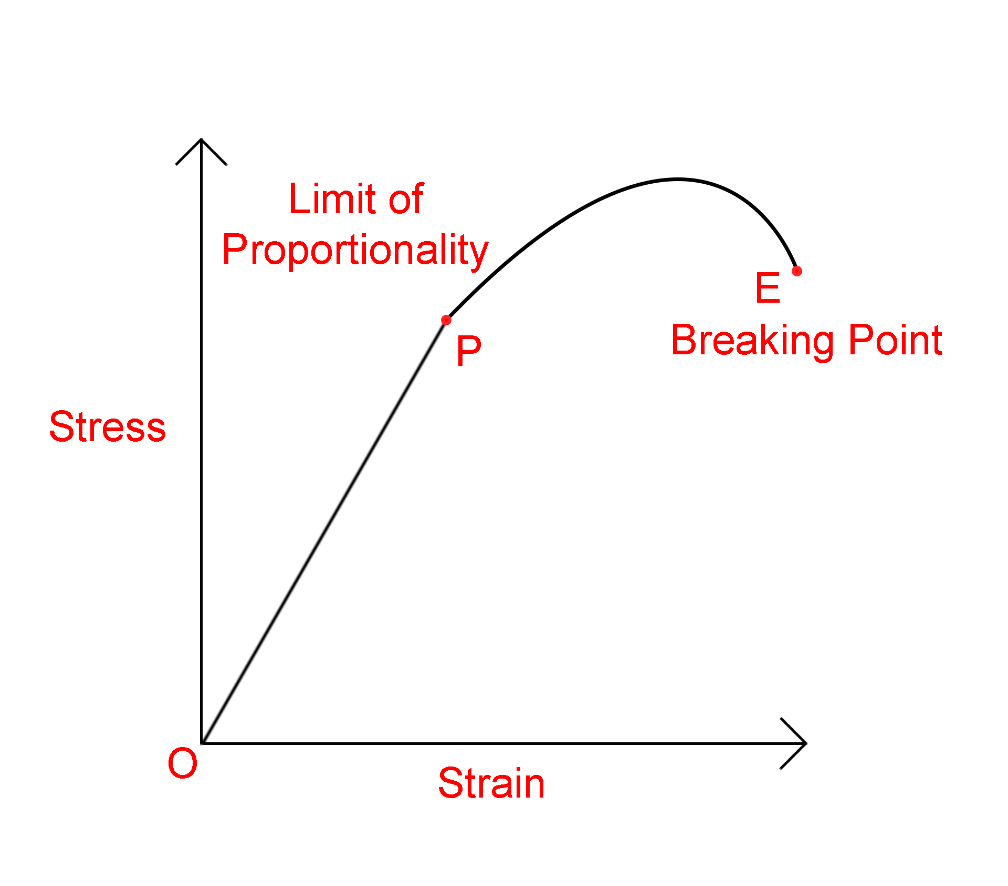
The breaking stress of a wire depends upon
A. The length of the wire
B. The radius of the wire
C. The material of the wire
D. The shape of the cross-section
Answer
483.9k+ views
Hint: We know that the equation for the relation of stress and strain is $\dfrac{{Stress}}{{Strain}} = \gamma $ . This means that the stress on an object depends on $\gamma $ . Now $\gamma $ as we already know depends upon the material that makes up the wire.
Complete answer:
Before starting the actual solution, it would be good to discuss stress, stress, and their relationship.
Stress – Stress is the force applied per unit area on a material.
Strain – Strain is the change in the dimensions of material when it is under stress.
The relation of stress-strain is given below
$\dfrac{{Stress}}{{Strain}} = \gamma $
Here, $\gamma = $ The proportionality of linear expansion
The stress-strain graph is shown below

In this graph, you can see the point E which is called the breaking point where the object can longer bear the stress and just breaks into two. At this point even if we reduce the stress the strain still increases.
By the stress-strain equation, i.e. $\dfrac{{Stress}}{{Strain}} = \gamma $ , we can see that the strain of a body does not depend on the length of the wire, the shape of the cross-section of the wire, and the radius of the wire.
But stress does depend on $\gamma $ . Now $\gamma $ depends on the material of the wire, so the breaking stress also depends on the material of the wire.
In simple words, it means that two objects made of different material will have different breaking stress (the limit of strain the body can bear)
So, the correct answer is “Option C”.
Note:
The concept of breaking stress that we discussed in the solution above is of great importance to us. Every object that we use whether it be lifts, bridges, mobiles phones, etc. are designed in such a manner that the stress on the object does not exceed the safe limit in normal day to day usage.
Complete answer:
Before starting the actual solution, it would be good to discuss stress, stress, and their relationship.
Stress – Stress is the force applied per unit area on a material.
Strain – Strain is the change in the dimensions of material when it is under stress.
The relation of stress-strain is given below
$\dfrac{{Stress}}{{Strain}} = \gamma $
Here, $\gamma = $ The proportionality of linear expansion
The stress-strain graph is shown below

In this graph, you can see the point E which is called the breaking point where the object can longer bear the stress and just breaks into two. At this point even if we reduce the stress the strain still increases.
By the stress-strain equation, i.e. $\dfrac{{Stress}}{{Strain}} = \gamma $ , we can see that the strain of a body does not depend on the length of the wire, the shape of the cross-section of the wire, and the radius of the wire.
But stress does depend on $\gamma $ . Now $\gamma $ depends on the material of the wire, so the breaking stress also depends on the material of the wire.
In simple words, it means that two objects made of different material will have different breaking stress (the limit of strain the body can bear)
So, the correct answer is “Option C”.
Note:
The concept of breaking stress that we discussed in the solution above is of great importance to us. Every object that we use whether it be lifts, bridges, mobiles phones, etc. are designed in such a manner that the stress on the object does not exceed the safe limit in normal day to day usage.
Recently Updated Pages
The correct geometry and hybridization for XeF4 are class 11 chemistry CBSE

Water softening by Clarks process uses ACalcium bicarbonate class 11 chemistry CBSE

With reference to graphite and diamond which of the class 11 chemistry CBSE

A certain household has consumed 250 units of energy class 11 physics CBSE

The lightest metal known is A beryllium B lithium C class 11 chemistry CBSE

What is the formula mass of the iodine molecule class 11 chemistry CBSE

Trending doubts
State the laws of reflection of light

One Metric ton is equal to kg A 10000 B 1000 C 100 class 11 physics CBSE

Difference Between Prokaryotic Cells and Eukaryotic Cells

What is the modal class for the following table given class 11 maths CBSE

How do I convert ms to kmh Give an example class 11 physics CBSE

Give an example of a solid solution in which the solute class 11 chemistry CBSE




